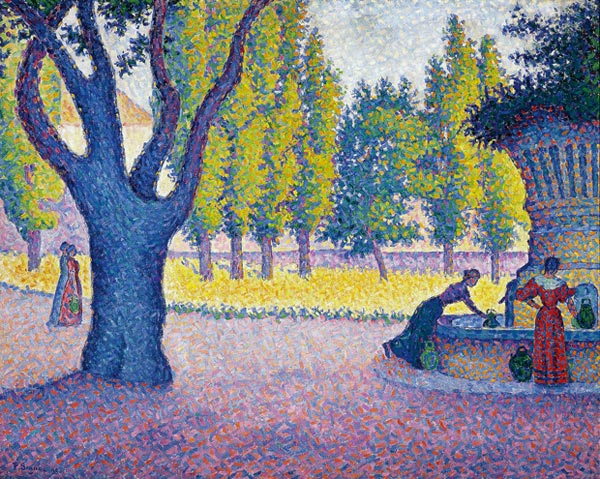admin On dicembre - 4 - 2013

THE AVANT-GARDES OF FIN-DE-SIÈCLE PARIS:
Signac, Bonnard, Redon, and their Contemporaries
Curated by Vivien Greene
September 28, 2013 – January 6, 2014
The exhibition The Avant-gardes of Fin-de-Siècle Paris: Signac, Bonnard, Redon, and their Contemporaries focuses on the avant-gardes of the late nineteenth century, with special attention paid to the Neo-Impressionist, Nabi, and Symbolist movements. Curated by Vivien Greene, Curator, 19th- and Early 20th-Century Art, Solomon R. Guggenheim Museum, New York, the exhibition includes approximately 100 paintings, drawings, and prints.
The fin de siècle in Paris was a time of political upheaval and cultural transformation. Mirroring the many facets of an anxious, unsettled era, this period saw a spectrum of artistic movements. By the late 1880s, a generation of artists had emerged that included Neo-Impressionists, the Nabis, and Symbolists. Their subject matter remained largely that of their still-active Impressionist antecedents: landscapes, the modern city, leisure-time activities, although these were joined by introspective scenes and fantastical visions. Concentrating on the activities of these movements, the exhibition explores certain artists in depth: Paul Signac, Maximilien Luce, Maurice Denis, Pierre Bonnard, Félix Vallotton, and Odilon Redon.
” href=”http://www.guggenheim-venice.it/exhibitions/avanguardie-parigine/img/gallery/signac.jpg”> |
|
” href=”http://www.guggenheim-venice.it/exhibitions/avanguardie-parigine/img/gallery/denis.jpg”> |
|
” href=”http://www.guggenheim-venice.it/exhibitions/avanguardie-parigine/img/gallery/vallaton.jpg”> |
|
|
|
|
|
PAUL SIGNAC
Saint-Tropez. Fontaine des Lices, 1895, oil on canvas, 65 x 81 cm, private collection |
|
MAURICE DENIS
Avril (Les anémones) (April [The Anemones]), 1891, oil on canvas,
65 x 78 cm, private collection |
|
FÉLIX VALLOTTON
Scène de rue (Street Scene), 1895, quill pen, india ink, colored pencils, and watercolor on paper, 24 x 38 cm, private collection |
The Neo-Impressionists originated in Paris in the mid-1880s. Principal artists of the group were Henri-Edmond Cross, Maximilien Luce, George Seurat, and Paul Signac, who were joined for a number of years by the former Impressionist Camille Pissarro. These innovative painters looked to scientific theories of color and perception to create optical effects in Pointillist canvases, and orchestrated complementary colors and mellifluous forms to render a unified whole. Utopian scenes that the Neo-Impressionists frequently represented in their works married ideological content and technical theory, but even when not guided by specifically politicized objectives, the Neo-Impressionists’ shimmering interpretations of city, suburb, or countryside often reflected idealized places of harmony.
The Nabis, from the Hebrew word for “prophets,” resembled a secret sect or religious society in their formation and founding philosophy, which understood art as a means to surpass the material for a numinous dimension. They were a loosely connected group whose art was influenced by Paul Gauguin’s Synthetism and by Japanese prints. Renouncing easel painting, the Nabis’ work traversed mediums, to decorative schemes, prints, and illustrations for journals. The group included the central figures Pierre Bonnard, Maurice Denis, and Édouard Vuillard.
The Symbolist movement crossed national boundaries. It embraced mythic narratives, suggestive imagery, and the macabre world of nightmares, abandoning the factual for the fantastic, the exterior world for the drama of psychological landscapes, the material for the spiritual, and the concrete for the ethereal. Decorative idioms, nourished by Art Nouveau’s organic motifs and arabesque forms informed their art. French artists associated with Symbolism were Georges Lacombe, Charles Filiger, and Odilon Redon.
Related Images:



